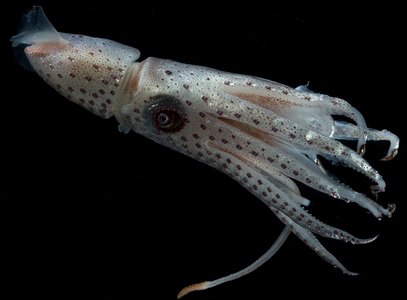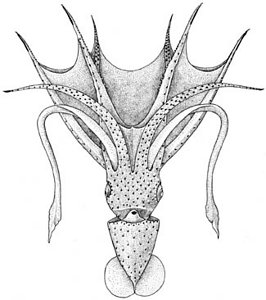Histioteuthis bonnellii
Richard E. Young and Michael VecchioneIntroduction
H. bonnellii is the type species of the genus. It reaches a rather large size (33 cm ML, 119 cm total length) for a histioteuthid. Its uneven distribution and variation in characters normally considered stable within species suggests that a number of separate populations exist.
Brief diagnosis
A Histioteuthis ...- with three series of photophores on arms III.
- with three large, dark, round photophores on the ventrolateral corner of the head.
Characteristics
- Buccal crown
- Buccal crown with 6 buccal supports.
- Buccal crown with 6 buccal supports.
- Head
- Beaks: Descriptions can be found here: Lower beak; upper beak.
- Beaks: Descriptions can be found here: Lower beak; upper beak.
- Photophores
- Compound photophores number 17 (rarely 16 or 18) around right eye.
- 3 large, round, dark photophores on left posterior margin of ventral surface of head (see drawing to the right).
 Click on an image to view larger version & data in a new window
Click on an image to view larger version & data in a new window

Figure. Ventral view of left-ventral region of head of H. bonnellii. Left - 42 mm ML, female, 43°N, 61°W. Drawing from Voss, et al. (1998). Arrows point to the three large photophores. Right - The three large photophores are clearly seen and show a blue-green color in this living squid. The white box is enlarged in the adjacent insert. The white arrow points to one of the small, "simple" photophores found near the large eye but it does not appear to be simple. The black arrows point to the remnants of the anterior reflector and color filiter (red) of two of the large photophores. The remnants could not be seen on the third large photophore which is not in the insert. Note the two normal photophores to the left and an intermediate photophore beween the uppper black and the white arrows; photographed in a shipboard aquarium by .
Comments
More details of the description can be found here.
Species of the bonnellii-group are distinguished by the following characteristics:
- Photophores
- Single, elongate, simple photophore at end of each arm I-III.
- Type 1b head photophore pattern (needs confirmation from H. macrohista).
- Two or three large, round photophores on left posteroventral margin of head.
- Compound photophores of large, uniform size on anterior half of ventral mantle.
- Arms IV with 3 longitudinal series on arm base and without separated group of compound photophores at arm tips.
- Web
- Deep inner web between arms I-III (>50% of length of longest arm; no other species have webs > 30%).
- Buccal membrane attachments
- Multiple attachments of the fourth (ventral) supports of the buccal crown (i.e., 1 each to sides of arms IV and to junctures of web segments from arms III and IV).
- Tubercles
- Absent
This species is most easily separated from its close relative, H. macrohista by the presence of 6, rather than 7, supports in the buccal crown, 17 rather than 16 photophores on the right eyelid (numbers rarely overlap) and the presence of 3 rather than 2 conspicuous, dark, round photophores on the posteroventral margin of the head on the left side. An additional difference is the manner that the inner webs between the third arms join those of the ventral arms. In H. bonnellii the two junctions nearly form a common junction, while in H. macrohista they are widely separated. Voss, et al. (1998) also show differences in sperm mass length and number of loops in the ejaculatory apparatus of the spermatophores, in the number of gill lamellae as well as the usual presence of an elongate, simple but relatively small photophore on the tips of arms IV.
The above description, comparisons and comments, with the exception of the head photophore pattern, is taken from Voss, et al., 1998.
We list the head photophore pattern for the bonnellii-group as Type 1b. We have only examined H. bonnellii, however, drawings in Voss (1969) suggest that H. macrohista also has this pattern.
Nomenclature
Clarke (1980) described a subspecies, H. b. corpuscula, from whale stomach taken in the South Atlantic (type locality - 30°S,31°E). Voss et al., 1998, in an extensive study of the species, found that the characters Clarke used to separate the subspecies were insufficient. They suggest, however, that different populations of the species may exist based on differences in spermatophore structure. If this proves correct, they suggest that the Atlantic subtropical form could be identified to H. b. corpuscula.
Life History
Largest mature female known is 33 cm ML from subarctic waters and carried mature eggs of 2.3 mm diameter (Kristensen, 1980). Females may mature at 70 mm ML in tropical waters. Mature males are known from 50-330 mm ML depending somewhat on latitude (Voss, et al., 1998).


Figure. Dorsal view of a young (8.7 mm ML) H. bonnellii, 37° 58'N, 27° 39' W. Drawing from Voss, 1969 (Fig. 35c).
Distribution
Geographical distribution
Type locality: Mediterranean Sea, off Nice.
H. bonnellii is widely but unevenly distributed in the Atlantic. It is absent from northern subropical and western tropical waters and probably other areas. It is found in a narrow band of subtropical waters that includes areas off Argentina, South Africa and the region between Australia and New Zealand (Voss et al., 1998). Voss et al. (1998) suggest that the species is absent from oligotrophic waters of the world's oceans and that three populations of this species may exist in the Atlantic ocean (i.e., Southwest Atlantic, Eastern Tropical Atlantic, Northwest Atlantic) based on differences in the structure of the spermatophores.

Figure. Distribution chart of H. bonnellii, modified from Voss, et al., 1998.
Title Illustrations

About This Page

University of Hawaii, Honolulu, HI, USA

National Museum of Natural History, Washington, D. C. , USA
Correspondence regarding this page should be directed to Richard E. Young at and Michael Vecchione at
Page copyright © 2013 and
 Page: Tree of Life
Histioteuthis bonnellii .
Authored by
Richard E. Young and Michael Vecchione.
The TEXT of this page is licensed under the
Creative Commons Attribution-NonCommercial License - Version 3.0. Note that images and other media
featured on this page are each governed by their own license, and they may or may not be available
for reuse. Click on an image or a media link to access the media data window, which provides the
relevant licensing information. For the general terms and conditions of ToL material reuse and
redistribution, please see the Tree of Life Copyright
Policies.
Page: Tree of Life
Histioteuthis bonnellii .
Authored by
Richard E. Young and Michael Vecchione.
The TEXT of this page is licensed under the
Creative Commons Attribution-NonCommercial License - Version 3.0. Note that images and other media
featured on this page are each governed by their own license, and they may or may not be available
for reuse. Click on an image or a media link to access the media data window, which provides the
relevant licensing information. For the general terms and conditions of ToL material reuse and
redistribution, please see the Tree of Life Copyright
Policies.
- First online 02 November 2005
- Content changed 15 August 2010
Citing this page:
Young, Richard E. and Michael Vecchione. 2010. Histioteuthis bonnellii . Version 15 August 2010 (under construction). http://tolweb.org/Histioteuthis_bonnellii/19786/2010.08.15 in The Tree of Life Web Project, http://tolweb.org/










 Go to quick links
Go to quick search
Go to navigation for this section of the ToL site
Go to detailed links for the ToL site
Go to quick links
Go to quick search
Go to navigation for this section of the ToL site
Go to detailed links for the ToL site